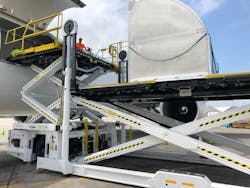While the COVID-19 pandemic has negatively impacted air travel for the last two years, opportunities for air cargo have remained steady and, in many cases, increased.
Earlier this year, the International Air Transport Association (IATA) released data for global air freight markets. According to IATA, full-year demand for air cargo increased by 6.9 percent in 2021, compared to pre-COVID levels in 2019 and 18.7 percent compared to 2020.
IATA officials note this was the second biggest improvement in year-on-year demand since the organization began monitoring cargo performance in 1990. Only 2010’s 20.6 percent gain was larger than 2021’s performance.
The pandemic’s influence on consumer purchasing habits, coupled with the pandemic’s role in slowing production created a massive demand for goods and services.
“The demand for goods and services is at an all-time high,” says Bryan Del Monte, president of The Aviation Agency.
“Will it stay at that tremendous height forever? No. At some point, things will equalize. But the demand for goods and services, I don’t foresee as an economist, any reason why suddenly there would be a contraction,” he adds. “We’re way too reliant on the free flow of goods. In the past two years, air cargo filled in that gap.”
With cargo serving a vital role globally, the need to facilitate air cargo throughput remains crucial. To assist the cargo handling segment, many ground support equipment (GSE) manufacturers are providing solutions to benefit the ground handling industry. The following are just a few examples of those cargo handling innovations.
JBT’s Electric Approach to Cargo
With decades of experience producing electric and alternative powered ground support equipment, JBT has applied this know-how to cargo handling equipment.
The C30i E electric powered main deck loader debuted in 2018. Later this year, the company will start production on a new variation with an extended range.
The Commander 30i E is part of the company’s continued push to make clean energy versions for all of its products, explains JBT's Kevin Cecil, engineering manager - loaders, and Gary Walter, ground support equipment regional director - the Americas.
“The Commander Cargo Loader lineup has electric versions of the C15i and C30i available today. C40i and C60i will be part of the continued development in the near future,” Cecil and Walter say.
“The Ranger Cargo Loader is also available in electric and we have also done a trial with a hydrogen fuel cell in place of a battery as a proof of concept.”
By moving to electric products, JBT officials are seeing more efficiency, less use of power, less emissions and lower maintenance costs.
However, Cecil and Walter notes that all new developments come with challenges, including engineering development, supplier lead-times and more.
“One place we can see a need across suppliers is for better standardization of charging connectors, message protocols, etc., to allow customers to have options that work regardless of the OEM, batteries or chargers they choose to utilize,” Cecil and Walter say. “This is an opportunity for the industry to come together and set standards for this via SAE, IATA, CE, CAAC or others as needed.”
Moving forward, JBT is looking to integrate common design principles and components across all of its products, according to Cecil and Walter.
“This will allow for better component utilization, better reliability, and will also help with maintenance and training for customers,” they say.
Beyond its electric offerings, JBT started production on the Falcon Cargo Loader in 2020. The Falcon was launched as more containerized regional aircraft became prevalent in the industry versus traditional bulk load configurations, Cecil and Walter explain.
“With the ATR, Cessna and CRJ filling a new spot with smaller aircraft, lower door heights and minimal containers and lower container weights, the traditional dual platform cargo loaders were too big for this application and a new ground up design was needed,” Cecil and Walter say.
“By moving to containerized cargo, more synergies can be found in the freight network and handling,” they add. “It is also better for all weather conditions and can increase the speed of the onload/offload.”
FAST’s Focus on Ergonomics and Safety
Looking to provide a cargo handling solution that reduces fuel consumption, improves total cost of ownership, offers commonality within an existing fleet and improves safety and ergonomics, officials at FAST Global Solutions began developing the M-Series Cargo Dolly in 2018 and paired the dolly with its proprietary EasyLift Towbar.
“The M-Series dolly's development began in 2018 with prototyping, testing, modeling and FEA, a true ground-up engineering development. Currently, the M-Series is at the pilot stage with full production launching this year and orders starting to line up,” says Tim Hildebrandt, vice president of sales at FAST Global Solutions.
According to Hildebrandt, the M-Series Dolly incorporates ergonomics, safety and the ability to integrate with existing fleet equipment. What’s more, the EasyLift Towbar System allows increased control during tow-bar motion and lowers the forces required to raise the tow-bar. The EasyLift Towbar improves the ergonomics for ramp operations teams when attaching or disconnecting units, providing a 60 percent reduction in lifting forces compared to standard tow-bars.
“By integrating the collective needs into our engineering process, the result is a dolly with commonality to marry into existing fleets of equipment and to accept parts and enhancements within the inventory the customer purchases,” Hildebrandt says.
Hildebrandt notes FAST plans to continue engineering variations of this platform, innovating alongside its customers’ end-users for functionality that meets safety requirements and efficiency demands.
Currently the M-Series is produced in the United States, with plans for the company’s European production facility to fulfill demand from its international customers.
“Feedback has been positive, even more so when paired with the EasyLift Towbar and for all the previously mentioned advantages,” Hildebrandt says.
Clyde’s Emphasis on Cargo Dollies
Perhaps overlooked on the ramp, the cargo dolly’s role in meeting cargo demand is crucial.
“It is a critically important piece of equipment in moving containers from aircraft to warehouse and vice versa,” notes Chad Barsness, president at Clyde Machines.
Clyde’s line of cargo dollies, including the Model 15F3570, helps enable these functions.
The Model 15F3570 offers a cargo capacity of 15,000 pounds. Its trailer capacity is capable of handling LD1, 2, 3, 4, 6, 7, 8, 9, 11 and 29 containers as well as 88”x125”, 96”x125” and 88”x108” pallets.
“Customers really like the Model 15F3570 as it has all of the container lock configurations built into the dolly,” Barsness says.
It offers a recessed frame to protect customer markings, tow-bar actuated self-adjusting rear brakes, dual front-wheel swivel casters with rigid dual rear wheels and an E-type spring loaded hitch, among other features.
“We integrated caster protection plates and forklift tine ways into the structure of the main frame weldment. This was done based on feedback from customers trying to keep their maintenance costs down,” Barsness adds. “We are continuously working to improve current designs based on customer feedback and continue to innovate.”
As the industry shifts toward electric vehicles, Clyde officials are focused on keeping the weight of the dolly as low as possible to facilitate transport without compromising the durability and lifecycle of the dolly, itself.
The Model 15F3570 is part of Clyde’s line of cargo pallet trailers that also includes the Model 15F3680, Model 15F3580, Model 15F2710 and Model 15F3285.
“The main difference is container stop options and caster protection options,” says Barsness. “We also offer roller bed and caster bed options as well.”
MULAG Expands Pulsar Line
MULAG’s Pulsar 7 E is a container pallet transporter with electric drive that can transport heavy cargo, standard LD and MD containers and pallets up to 196" (5640 mm) without CO2 emissions.
The cargo loader is powered by two 12 kW asynchronous motors and two 465 Ah traction batteries. The vehicle travels up to 15.5 mph (25 km/h).
“Ground service providers and airlines benefit from the quality and reliability of the Pulsar 7 E, which builds on decades of experience in the development and manufacture of container pallet transporters,” says Daniel Müller, area sales manager for GSE at MULAG. “Thanks to the innovative electric drive technology, the product requires less maintenance and can be used ecologically sustainable in airport operations.”
Following the introduction and development of the Pulsar 7E electric container transporter in 2015, officials at MULAG introduced the Pulsar 7 SL side-loader container transporter at the end of 2021. The Pulsar 7 SL offers a revised cab concept and new electronic control platform.
“The technical design of the Pulsar container pallet transporters was optimized in the course of further development by means of a modular component system, and electrification and digitalization were further advanced,” says Müller.
As part of a product family, there are also diesel-powered Pulsar container transporters with 7 tonne and 14 tonne payloads, as well as a side-loading version where container pallets can also be received and transported at 90 degrees from the side.
“The main difference besides the payload is the size of the roller bed for handling up to three pallets at a time. In recent years, there has also existed a high-loader variant as a special solution in this product range, which is mainly used in the defense sector,” Müller says.
MULAG’s product range will continue to be developed and expanded, in regard to future-oriented drive technologies, Müller adds.
Units from the Pulsar container pallet transporter range are in use at European and international airports in a variety of configurations, including some of which that are customer-specific, Müller says.
About the Author
Josh Smith
Editor
Josh Smith served as editor of Ground Support Worldwide as editor from 2016 through 2024. He oversaw production of the print magazine, created GSW's newsletters on a daily basis, and updated the latest news on AviationPros.com.

